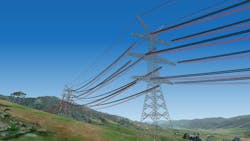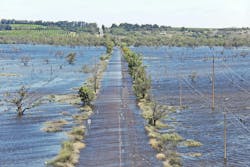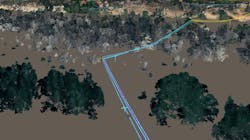From Reaction to Prevention: Protecting Critical Infrastructure From Extreme Weather
In an era marked by increasingly frequent and severe weather events, the need to modernise the maintenance of critical infrastructure to mitigate risk has never been more pressing. Australia sits in a unique position globally, experiencing the devastation of extreme floods and bushfires within months, weeks and even days. The impact on citizens over the last decade has been devastating, with re-energisation strategies the subject of new government enquiries.
The growing threat of ongoing, sustained, and increasingly ferocious extreme weather events is not just restricted to Australia, with much of the world now experiencing severe weather events at an unprecedented scale. Storm Isha plunged thousands of UK households into darkness, and a recent wave of winter storms across the United States (US) left over a hundred thousand people without power. This resulted in both equipment-related deaths in Oregon and outage-related deaths in the Southeast. The northern Australian state of Queensland and its supporting infrastructure have been placed under immense, continued pressure, experiencing waves of tropical cyclone weather conditions followed by extensive heat waves. The result of each of these global events? A constant squeeze on the supply of power to the electricity grid.
As the frequency of extreme weather events increases, their effects on consumers and the electricity grid cannot be classified as unusual. Utility providers and government bodies across the globe must modernise their approach to extreme weather and natural disasters to be pre-emptive, not reactive. Strong progress has already been made by utilities in their management of grid infrastructure during or post natural disasters, but additional work must be done to pre-emptively mitigate the impact of extreme weather events on energy infrastructure.
The volume of data and insights available on shifting climate patterns and the subsequent impact on the natural environment is significant. When utilised to its full extent, this data can enable network service providers (NSPs) to prepare for extreme weather scenarios by deploying pre-analysed risk mitigation strategies as the event occurs, rather than in response. Such strategies can involve simulations and analysis of which areas of the network are particularly damage-prone given certain weather event parameters (like wind speed) and where the greatest community impact will likely manifest. This can either inform pre-emptive network resiliency investment or the pre-configuration of rebuild design templates capable of refinement during and following an event. Once efficiently deployed, the approach can ensure network infrastructure is built back with an improved resilience profile, rather than just the state it was in before the weather event occurred.
The following networks are leading from the front in their extreme weather management strategies, with their capabilities and insights set to inform the next wave of risk/value analysis urgently required to keep citizens across the globe safe and connected.
SA Power Networks
The 2022-2023 River Murray flooding event in South Australia was unprecedented in magnitude, now recognised as South Australia’s most significant natural disaster to date. The extent of the flooding and its impact on the community living and working throughout the 650-kilometre stretch of the River Murray was immense, hitting thousands of homes, businesses, and people reliant on the river for their livelihoods.
As flood-level predictions escalated and the scale of the event became apparent, there was a pressing need for the state's critical infrastructure and electricity distribution network to be managed differently. The focus for SA Power Networks as the state's largest energy provider, was centred on limiting service disruption to river communities whilst keeping citizens, emergency service providers and workforces safe during the flooding disaster.
To facilitate these goals, traditional models of critical infrastructure management were not viable. The rate of rising flood waters was too fast for field crews to accommodate and manage shifting water levels on safe powerline clearance zones. A new approach underscored by artificial intelligence (AI) and LiDAR data processing capabilities was deployed to create a three-dimensional map of the entire River Murray region including all SA Power Network assets in the associated environment.
This was the provider's first deployment of AI-powered modelling capabilities in response to an extreme weather event and generated substantial results to change the decision-making process and enhance community safety. Reports analysing 21,000 powerline spans within 314GL per day flood area were completed every 15 minutes, a process that traditionally takes weeks, if not months, to complete through manual business systems and resources.
Network scenario modelling on different electricity distribution network assets at various flood levels, including where and when power line clearances could be breached requiring disconnection, customers were reconnected to electricity supply ahead of predicted timeframes. In some cases, regions were re-energised within five days compared to the projected three-week timeframe using traditional extreme weather event processes.
With a now completed analysis of the entire flood zone including supporting LiDAR data, SA Power Networks will determine how technology can be leveraged before future extreme weather events occur, with all response strategies underpinned by rapid network analysis to keep citizens safe and connected.
SP Energy Networks
Scotland's climate is changing, quickly. Scientific predictions on shifting climate patterns are now being experienced thirty years ahead of schedule, with the frequency and severity of extreme weather events impacting Scottish citizens, homes and businesses along with existing infrastructure.
Storm Arwen was the first of multiple extreme weather events to hit Scotland's east coast in late 2021 and early 2022, causing widespread network infrastructure damage and power disruptions. Described by the United Kingdom’s Met Office as “one of the most powerful and damaging winter storms of the last decade”, Storm Arwen's wind speeds hit over 140 kph per hour and caused one million homes to be disconnected from their power supply.
With the impact of Storm Arwen widespread, SP Energy Networks, the distribution and transmission network operator responsible for keeping electricity flowing to 3.5 million homes and businesses across Central and Southern Scotland and North Wales, doubled down on the weather resilience and grid hardening aspects of their storm management strategy.
By leveraging data sources including LiDAR, geographic information system mapping (GIS) and severe weather area protection zones, SP Energy Networks used weather simulations and asset health indicators to gauge equipment’s structural health and ability to withstand future severe weather events. This output helped develop a heatmap used to inform potential design upgrades across the grid, allowing SP Energy Networks to prioritise specific network upgrades including replacing certain assets at risk of failure, upgrading existing assets or simply applying methods of strengthening the assets.
The Next Wave of Risk Mitigation
Energy is a critical service that impacts every person around the globe, with the impacts of weather events now having a cataclysmic flow-on effect on citizens who urgently require energy access following an extreme weather event. There is no instant fix, but there are avenues to lessen the burden on businesses and families.
Right now, each asset in an electricity network is assessed on the likelihood of an event occurring that will subsequently cause it to fail and create a safety risk. The likelihood of an event occurring is then compounded with the severity of the damage or risk that could materialise from that event, whether it be bushfire, flood or extreme heat.
What is the likelihood of a pole failing that could create an ignition risk and cause a fire? What is the quantitative severity of that risk based on factors like proximity to local communities? And what is the cost of preventing that failure event and risk occurring in the first place by replacing said pole?
These are just some of the questions and scenarios performed on each individual network asset through manual risk/value analysis, ultimately producing significant redundancy and in some cases, proving incapable of preventing critical failures altogether.
As the frequency of these natural disasters rises, NSPs are now looking beyond digital models to predictive capabilities. The rapid development of artificial intelligence and machine learning capabilities will form the foundation of risk management strategies moving forward, as human judgement and manual inspections cannot keep pace with the shifting climate and environmental impacts.
Utilities are now shifting to a pre-emptive risk management approach to manage extreme weather events including bushfires and floods. While engineering-grade, highly configured digital network models are a significant innovation for NSPs, the return on investment is ongoing, provided by the continuous modelling capable of sourcing new applications in areas impacting network expenditure and risk.
The granularity of asset/risk analysis increases markedly through advanced digital twin modelling capabilities. This advanced feature could drastically increase the speed of weather-related risk identification, capable of assessing millions of unique assets to inform how utilities should allocate resources including funding, repairs and manual inspection.
Weathering the Storm: Protecting Our Power Grid
The exponential increase in extreme weather events is placing the world's energy providers under immense pressure, not only to help facilitate the growing volume of renewable energy entering the grid but to ensure existing infrastructure can provide reliable, safe energy access for citizens. The accelerating frequency and ferocity of extreme weather events are making this task increasingly difficult, pushing the urgency behind new risk/value analysis and grid management capabilities to a critical high.
Providers are working quickly to update processes and practices during and following extreme weather situations, but the immediate impact on infrastructure and citizens is significant and requires urgent action. The long-term outcome of pre-emptive risk management strategies could be immense, and while great strides have been made, NSPs must look ahead and embrace pre-emptive extreme weather risk strategies as a priority, with AI having a massive role to play. This shift in approach will not only save thousands of dollars and hours but fundamentally change the experience of citizens increasingly suffering from blackout fatigue.
About the Author
Jack Curtis
Jack Curtis, Neara Co-Founder and CCO


